Once a niche, compact crossovers have become a core market segment, with plenty to choose from. Nissan has redesigned its entry for the 2014 model year. What separates the new Rogue from the herd?
And which member of the herd poses the toughest challenge?
One segment leader, the Honda CR-V, is overdue for a redesign. The Ford Escape and Mazda CX-5 target people who want a healthy dose of sport with their utility. The Toyota RAV4 can't be equipped as lavishly as the others. The Mitsubishi Outlander is the only contender aside from the Rogue that can be ordered with a third-row seat, but generally isn't competitive and is consequently a minor player.
I think I've found it. The Subaru Forester (also redesigned for 2014) stakes out a position close to the Nissan's and has been extremely popular among TrueDelta's members. Are there any good reasons they should have bought a Rogue instead?
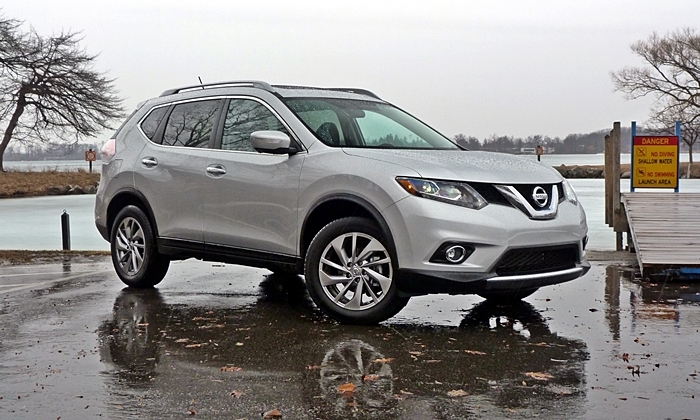
The Rogue appears fairly aggressive, without appearing mean or angry. more Rogue photos
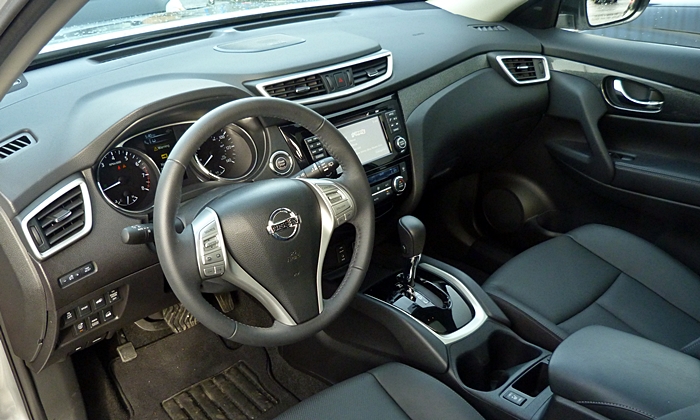
Upscale styling with many soft surfaces.
| |
Compared to the Forester |
| Fuel economy |
 Better
Worse
Better
Worse
|
Though more fuel-efficient than heavier, truck-based SUVs, crossovers have remained much less fuel-efficient than lower, lighter, more aerodynamic cars. Especially if they are equipped with all-wheel-drive (AWD), which adds weight and drivetrain friction. Still, their efficiency has been improving.
With EPA ratings of 25 mpg city, 32 mpg highway, the all-wheel-drive 2014 Nissan Rogue is the most fuel efficient compact crossover. (Add one mpg for the front-wheel-drive Rogue.) The new Subaru Forester comes close, with 24/32, followed by the Mazda CX-5 (24/30) and Mitsubishi Outlander (24/29). The Ford Escape (22/30), Honda CR-V (22/30) and Toyota RAV4 (22/29) lag behind the others.
In the real world, the Rogue had no trouble beating the EPA estimates. In suburban driving the trip computer typically reported averages between 27 and 31. On one 65-mph highway run downtown, the trip computer reported 40.6 on the way there, then 27.9 on the return. Wind? That, and perhaps my foot wasn't as light. Though the latter figure is much less impressive, the two-way average of 34 is quite good for an all-wheel-drive crossover, especially with the outside temperature just above freezing.
I tested the Subaru Forester in colder weather with a lot of snow on the roads, so unfortunately I cannot provide comparable real-world figures for it. The averages I did observe plus the EPA estimates suggest it should be not quite as efficient, but close enough that I'm calling this one a tie. Unless you don't need all-wheel-drive. Then the Rogue has an edge.
Notably, both vehicles have continuously variable transmissions (CVTs).
| Rear seat room & comfort |
 Better
Worse
Better
Worse
|
Both the Rogue and the Forester have roomy rear seats mounted higher off the floor than most, and thus better suited for adult comfort and non-adult outward visibility. But only the Nissan has air vents back there.
The Rogue is also one of the only members of the segment to offer a third-row seat, the others being the Mitsubishi Outlander and the Kia Sorento (which in width and price actually falls between compact and midsize). Unlike in the others, though, you cannot get a third-row seat with the Rogue's top trim level. So you must choose between the third-row seat on the one hand and the SL's additional features (heated leather seats, Bose audio system, forward collision alert, LED headlights) on the other. You also cannot get the third-row seat with the panoramic sunroof.
The tested vehicle was the SL, so no third-row seat. Judging from the specs, it should be roomier than that in the Outlander, and about a match for that in the Sorento. Adults might fit in a pinch, but it's probably best to think of the seat as kids-only.
Combine this third-row seat availability with the Rogue's EPA ratings, and you have the most fuel-efficient vehicle that can seat seven (but not on leather).
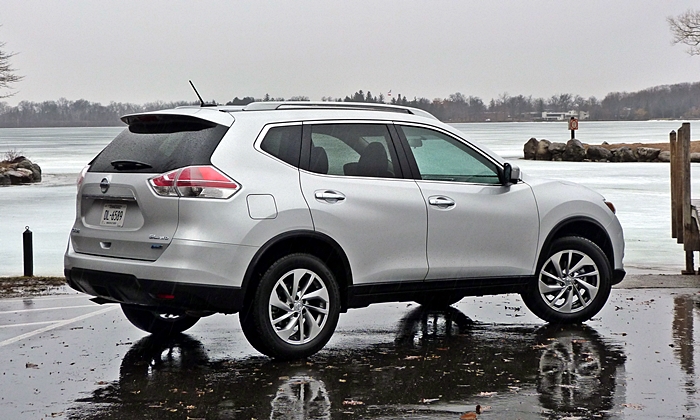
Curves in front fender especially interesting from this angle.
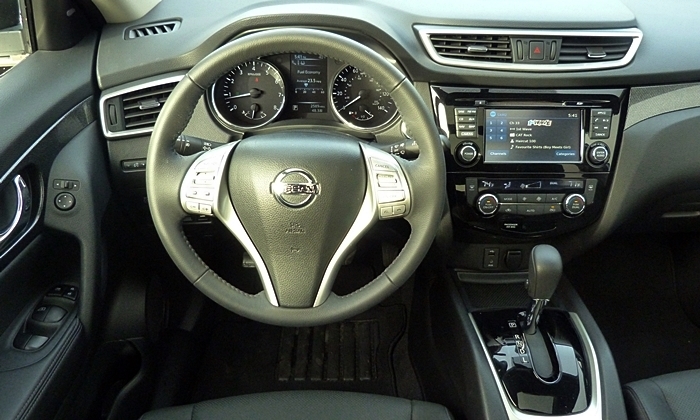
Controls easier to reach and operate than most these days.
| Cargo capacity |
 Better
Worse
Better
Worse
|
Don't expect much cargo space behind the optional third-row seat. Otherwise, the Rogue's cargo volume places it near the most capacious models in the class, if not quite among them (70.0 cubic feet vs. the RAV4's 73.4 and Forester's 74.7).
But cargo volume isn't everything. The Rogue includes a pair of innovative, versatile cargo shelves / dividers that can be positioned horizontally (at three different levels) or vertically to organize and secure your cargo. With the second row folded, you can choose between the lowest possible floor and a level floor.
Opt for the third-row seat, and one shelf / divider is deleted.
| Feature availability |
 Better
Worse
Better
Worse
|
But wait, there's more! The third-row seat and shelf / divider system aren't the only Rogue features you'll find on few if any competitors. You can also get an around-view camera system (extremely useful in parking lots), a panoramic sunroof, LED headlights, and a slew of electronic safety monitors (forward collision warning, moving object detection, blind spot warning, lane departure warning).
While the Forester doesn't offer a third-row seat, LED headlights, around-view cameras, moving object detection, or blind spot warning, it does offer adaptive cruise control with automatic braking.
| Price or payments |
 Better
Worse
Better
Worse
|
The Subaru Forester's price undercuts those of the CR-V and RAV4, and rates among the best reasons to buy one. The Rogue is even less expensive, though. Load one up like the test vehicle (SL with the $1,990 Premium Package and floor mats), and the list comes to $32,395, $825 less than a Forester 2.5i Touring with its $2,400 Driver Assist Technology Package. Adjust for remaining feature differences, and the Nissan's advantage widens to about $1,300.
A loaded Mitsubishi Outlander SE checks in $600 below the tested Rogue, but adjust for features and the Rogue comes out $1,800 lower.
Not looking for a loaded vehicle? A base Forester undercuts a base Rogue with AWD by $880, but the Nissan has about $1,500 in additional content.
Instead of offering a Rogue with less content at a lower price, Nissan has opted to continue selling the first-generation Rogue as the "Rogue Select." The old design lists for $2,500 less than the new one, but the new one has about $2,600 in additional content. In other words, if you adjust for feature differences it's a wash. Personally, I'd find the extra cash for the new one.
| |
Compared to the Forester |
| Powertrain performance |
 Better
Worse
Better
Worse
|
Thanks to the ability of the CVT to rev the engine to the optimal rpm for any given situation, then hold it there, the Nissan Rogue's 170-horsepower 2.5-liter four-cylinder motivates the crossover's 3,500 pounds well enough in typical driving. When driven for maximum fuel economy, the engine pulls smoothly (if not strongly) at a steady 1,500 rpm. Request extra scoot, and the powertrain steps up, but enraged leaf blower soundtrack doesn't encourage this. This powertrain is best suited to casual, efficiency-oriented driving. No other engine is offered.
Though virtually identical in size and power rating, and also paired with a CVT, the Subaru Forester's flat four-cylinder engine sounds better when revved. And, if you want strong acceleration, Subaru offers a 250-horsepower turbocharged engine (separately reviewed here).
| Handling |
 Better
Worse
Better
Worse
|
The Nissan Rogue's standard torque vectoring system selectively applies the brakes to counteract the tendency of its nose-heavy chassis to plow towards the outside curb in hard turns ("understeer," if you want to get technical). But the chassis otherwise favors ride quality over handling. The Rogue leans more in hard turns than most competitors. Body motions don't feel as well controlled as they are in the Subaru. For this and other, more subtle reasons I found the experience of driving the less bland Forester more engaging and enjoyable.
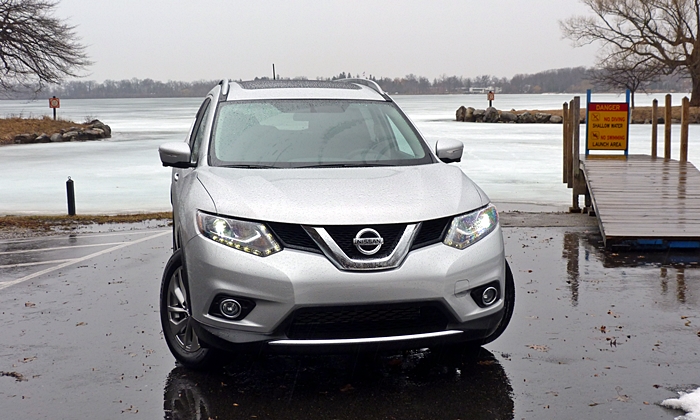
Corporate grille, LED headlights.
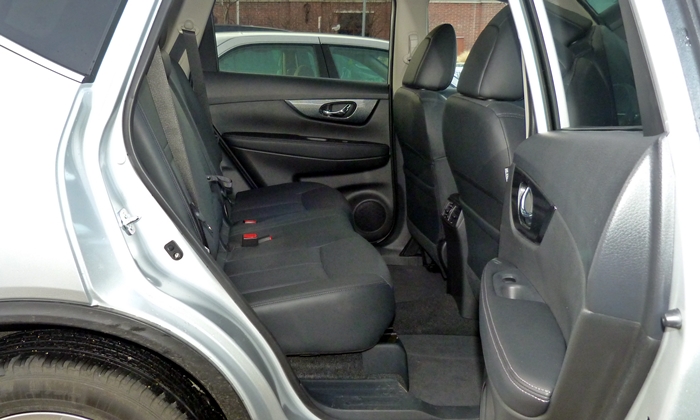
Comfortable, high-mounted second-row seats. Third row optional except on the top-of-the-line SL.
| Front seat support & comfort |
 Better
Worse
Better
Worse
|
The Rogue SL's leather-trimmed seats appear luxurious, but like those in some other recent Nissans (with the notable exception of the Altima) feel flat and overly firm. The power seat adjustments include height, but not tilt. Mazda has also started deleting the driver seat tilt adjustment, and both automakers deserve to be taken to task for this. Those with upright builds (including me) will find that the Rogue's front seat headrests jut too far forward. The Forester's front seats are more comfortable.
| |
Compared to the Forester |
| Exterior styling |
 Better
Worse
Better
Worse
|
The more you look at the Nissan Rogue's exterior, the more details you'll notice. There's a lot going on. But do these details come together to form an attractive whole?
There's more style here than in the Forester (designers possess little power within Subaru's organization), and the exterior is less of a mess than Honda's equally ambitious effort with the CR-V.
Yet I don't recall anyone praising the Rogue as beautiful. It looks more striking in some of these photos than I recall from my week with the car. Something, perhaps the width of the flat bands around the wheel openings, isn't quite right.
| Interior styling |
 Better
Worse
Better
Worse
|
If I had a sixth "why to buy" slot, I'd stick interior styling in it. The Rogue's interior is more conservatively styled than its exterior, and generally comes across as more upscale and up-to-date than the Forester's. This won't be to everyone's taste. But those seeking traditional upscale styling inside an affordably priced compact crossover will likely find the Nissan's interior the most attractive of the bunch.
| Materials & workmanship |
 Better
Worse
Better
Worse
|
Soft and upholstered surfaces abound within the new Nissan Rogue. Oddly, unlike in the more expensive Nissan Pathfinder, the upper instrument panel is among these. The door pulls feel solid.
Yet no one will think they're inside an Audi. Subtle impressions, from the switchgear, and from the seat of your pants while driving, betray a fairly average structure beneath the upscale styling and soft surfaces. No surprise, this. If it was possible to produce an Audi at two-thirds the price, there would be no Audi.
| Driving position & visibility |
 Better
Worse
Better
Worse
|
The view forward from the Rogue's driver seat is fairly open, if not quite as open as in the even more upright Forester. The view to the rear is much more constricted than in the Subaru thanks to a rising belt line (base of the side windows) and thick rear pillars. To compensate, Nissan does offer the blind spot warning system and the around-view camera system mentioned earlier. On Rogues without these options visibility would rate a "why not to buy."
| Ride smoothness |
 Better
Worse
Better
Worse
|
The Rogue's relatively soft suspension tuning and some "active ride control" trickery via the brakes pay off in better bump absorption and a steadier ride (with less pitching fore-and-aft) than in the typical compact crossover. Though the wheels are large, 18 inchers on the SL, you don't feel their mass dropping into divots and pounding over bumps. Noise levels aren't the lowest, but are fairly low. The Subaru is pretty close in both regards.
Despite its name, the Nissan Rogue isn't an exciting, non-conforming vehicle, and won't be the choice for those seeking quick acceleration, agile handling, or in-your-face styling in a compact crossover. (So don't expect too much praise from the car enthusiast magazines.) But it has strengths in more practical areas, including segment-leading fuel economy, second-row comfort, a third-row option, cargo-carrying versatility, and a relatively low price. Combine a couple of these, and you have the most fuel-efficient vehicle that can carry seven people.
If you care more about this second, more practical set of criteria, then you definitely should check out the Rogue. And the Forester--unless you need that third row, don't need all-wheel-drive, or want some style with your crossover.

Adequate performance, segment-leading fuel efficiency.

The shelf / dividers can be raised a couple inches to create a flat floor.
See more 2014 Nissan Rogue photos
Nissan and Subaru each provided an insured car for a week with a tank of gas.











